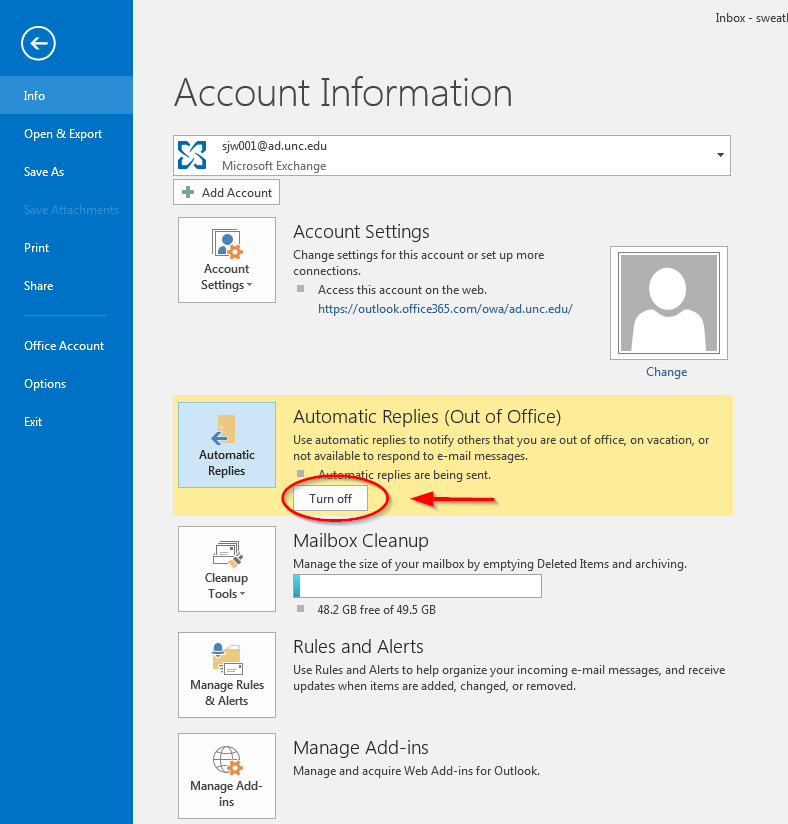Mastering Email Etiquette: A Comprehensive Guide on How to Enable and Disable Out of Office Replies in Outlook

Introduction:
Outlook, Microsoft’s widely-used email client, provides a robust set of features to enhance productivity and communication. One such feature is the Out of Office (OOF) auto-reply, a valuable tool for informing colleagues and clients about your unavailability. This comprehensive guide aims to demystify the process of enabling and disabling Out of Office replies in Outlook, ensuring that you can effectively manage your email communication during periods of absence.
Chapter 1: Understanding the Importance of Out of Office Replies
Before delving into the specifics, it’s crucial to understand why Out of Office replies matter. This chapter will explore the significance of using OOF responses, including maintaining professional communication, setting expectations, and managing workloads effectively. Recognizing the importance of OOF replies sets the stage for learning how to enable and disable them.
Chapter 2: Step-by-Step Guide to Enabling Out of Office Replies in Outlook
The first part of this guide focuses on the step-by-step process of enabling Out of Office replies in Outlook. This chapter will provide detailed instructions for Outlook versions such as Outlook 2010, 2013, 2016, and the web-based Outlook 365. Understanding how to set up your Out of Office message ensures that your contacts receive accurate and timely information about your absence.
Chapter 3: Enabling Out of Office Replies in Outlook 2010
For users of Outlook 2010, this chapter provides a detailed walkthrough of the process to enable Out of Office replies. It covers accessing the File tab, navigating to the Info tab, and setting up your auto-reply message. Mastering the steps in Outlook 2010 ensures that your OOF responses are activated seamlessly.
Chapter 4: Enabling Out of Office Replies in Outlook 2013
Outlook 2013 introduces slight variations in the process of enabling Out of Office replies. This chapter will guide users through the steps specific to Outlook 2013, including accessing the File tab, setting up automatic replies, and customizing the OOF message. Understanding the nuances of Outlook 2013 ensures a smooth activation of your Out of Office responses.
Chapter 5: Enabling Out of Office Replies in Outlook 2016
Outlook 2016 continues the evolution of the interface, requiring users to navigate specific steps to enable Out of Office replies. This chapter will provide a comprehensive guide for Outlook 2016 users, covering the process of accessing the File tab, setting up automatic replies, and customizing the content. Mastering the steps in Outlook 2016 ensures accurate activation of your Out of Office messages.
Chapter 6: Enabling Out of Office Replies in Outlook 365 (Web-Based)
For users utilizing the web-based Outlook 365, this chapter offers a step-by-step guide on enabling Out of Office replies. It covers accessing the Outlook 365 web portal, navigating to the settings, and configuring automatic replies. Understanding the web-based process ensures that users on the Outlook 365 platform can effectively activate their Out of Office responses.
Chapter 7: Step-by-Step Guide to Disabling Out of Office Replies in Outlook
Once your period of absence ends, it’s essential to disable Out of Office replies to resume regular email communication. This chapter provides a step-by-step guide on how to disable Out of Office replies in various Outlook versions, including Outlook 2010, 2013, 2016, and Outlook 365. Understanding the steps to turn off OOF responses ensures a seamless transition back to regular email correspondence.
Chapter 8: Disabling Out of Office Replies in Outlook 2010
For users of Outlook 2010, this chapter offers a detailed walkthrough on how to disable Out of Office replies. It covers accessing the File tab, navigating to the Info tab, and turning off automatic replies. Mastering the steps in Outlook 2010 ensures a swift deactivation of your Out of Office responses.
Chapter 9: Disabling Out of Office Replies in Outlook 2013
Outlook 2013 users will find specific steps to disable Out of Office replies in this chapter. It covers accessing the File tab, turning off automatic replies, and confirming the deactivation. Understanding the steps in Outlook 2013 ensures a quick and efficient disabling of your OOF responses.
Chapter 10: Disabling Out of Office Replies in Outlook 2016
Outlook 2016 introduces its own set of steps for disabling Out of Office replies. This chapter provides users with a comprehensive guide, covering the process of accessing the File tab, turning off automatic replies, and confirming the deactivation. Mastering the steps in Outlook 2016 ensures a smooth transition back to regular email communication.
Chapter 11: Disabling Out of Office Replies in Outlook 365 (Web-Based)
Users on the web-based Outlook 365 platform will find specific steps in this chapter to disable Out of Office replies. It covers accessing the Outlook 365 web portal, navigating to the settings, and turning off automatic replies. Understanding the web-based process ensures that users on the Outlook 365 platform can effectively deactivate their Out of Office responses.
Chapter 12: Tips and Best Practices for Effective Out of Office Management
To enhance your Out of Office management, this chapter provides tips and best practices. Topics covered include crafting concise and informative Out of Office messages, setting clear expectations, and managing exceptions. Incorporating these tips ensures that your Out of Office responses are well-received and contribute to effective communication.
Chapter 13: Advanced Techniques for Out of Office Management in Outlook
For users seeking to delve deeper into Out of Office management within Outlook, this chapter explores advanced techniques. Topics covered include utilizing conditional Out of Office responses, managing responses for shared mailboxes, and integrating Out of Office with calendar events. Understanding these advanced techniques expands your capabilities in managing your email presence effectively.
Chapter 14: Troubleshooting Common Issues in Out of Office Management
Despite the user-friendly interface of Outlook, users may encounter common issues during Out of Office management. This chapter will address potential challenges such as message delivery issues, incorrect configurations, and unexpected behavior. Troubleshooting tips and solutions will be provided to help users navigate and resolve common Out of Office management issues effectively.
Chapter 15: Integrating Third-Party Tools for Enhanced Out of Office Management
For users seeking additional features and capabilities, integrating third-party tools into the Out of Office management workflow is an option. This chapter will explore popular third-party tools, their features, and how to seamlessly incorporate them into Outlook for enhanced Out of Office management. Leveraging third-party tools provides a broader range of management possibilities.
Chapter 16: Future Trends in Out of Office Management
As technology evolves, the landscape of Out of Office management may see emerging trends. This chapter will explore potential future trends, including enhanced AI integration, more personalized response options, and increased automation. Staying informed about future trends prepares users for upcoming advancements in Out of Office management.
Chapter 17: Real-Life Out of Office Management Success Stories
To provide practical insights, this chapter will showcase real-life success stories of individuals and businesses that have effectively managed Out of Office responses in Outlook. Examining these experiences offers valuable lessons, tips, and inspiration for users embarking on their own Out of Office management endeavors.
Conclusion:
Effectively managing Out of Office replies in Outlook is a fundamental skill for maintaining professional communication and managing work-life balance. This comprehensive guide has equipped you with a step-by-step approach, tips, advanced techniques, and troubleshooting insights to seamlessly enable and disable Out of Office responses. Whether you’re a busy professional, a team leader, or an individual user, may this guide serve as a valuable companion in your journey to mastering Out of Office management in Microsoft Outlook.




